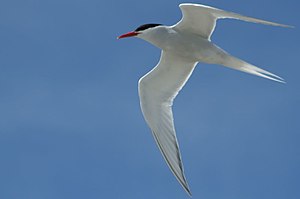Falkland Tern
| Falkland Tern | ||||||||||
|---|---|---|---|---|---|---|---|---|---|---|

Falkland Tern ( Sterna hirundinacea ) |
||||||||||
| Systematics | ||||||||||
|
||||||||||
| Scientific name | ||||||||||
| Sterna hirundinacea | ||||||||||
| Lesson , 1831 |
The Falkland Tern ( Sterna hirundinacea ) is a monotypical species from the family of the tern. It occurs exclusively in South America and the Falkland Islands .
Appearance
The Falkland Tern reaches a body length of 41 to 43 centimeters. The wing length is 28.4 to 31.5 centimeters and the wingspan is 84 to 96 centimeters. Falkland terns weigh between 172 and 196 grams. Males tend to have slightly longer tails than females.
The Falkland tern is thus a medium-sized species of tern. It is very light with a light gray body top and an even lighter body bottom. The tail is forked deep. The legs are relatively long for a Sterna species. Adult Falkland terns have a black head in their splendid plumage , and the color extends to the neck. The outer hand wings are a little darker than the rest of the wings. On the underside, the outer wings have weakly pronounced dark spots that form an indistinct, darker border. The beak and legs are red. In the plain dress the dark head cap is less pronounced, the forehead is whitish. The red color of the beak and legs is a little more dull than in the splendid dress. Fledglings resemble adults in simple dress. The beak is black and the feet are brownish-yellowish.
It can be confused with the Antipodean tern , the Arctic tern and the common tern .
distribution
The Falkland Tern breeds from the coasts of Peru and eastern Brazil to Tierra del Fuego. It is also a breeding bird in the Falkland Islands. Most of the population moves north after the breeding season and then also reaches the Pacific coast of Ecuador.
Way of life
The Falkland Tern mainly eats small fish and crustaceans and probably also insects. They occasionally catch their food by shock diving from heights of up to seven meters. During their foraging flights, they often follow porpoises and predatory fish.
The breeding season falls in the south of its range in the period October to January. In Brazil, however, it breeds between April and June. It is a colony breeder and breeds in densely populated colonies that occasionally include up to 10,000 breeding pairs. The nest is a shallow hollow, which is occasionally bordered with shells and stones and covered with grass. The clutch consists of two to three eggs. These are incubated for 21 to 23 days. The fledglings are fully fledged at around 27 days of age.
supporting documents
literature
- Hadoram Shirihai: A Complete Guide to Antarctic Wildlife - The Birds and Marine Mammals of the Antarctic Continent and Southern Ocean , Alula Press, Degerby 2002, ISBN 951-98947-0-5
Single receipts
Web link
- Sterna hirundinacea inthe IUCN 2013 Red List of Threatened Species . Listed by: BirdLife International, 2012. Retrieved October 12, 2013.